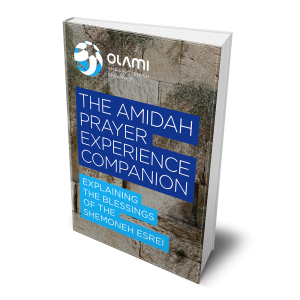
Amidah Prayer Experience Companion: Explaining the Blessings of the Shemoneh Esrei
One of the first mitzvot that a newcomer to Judaism begins to integrate into their life is prayer. The mere thought that there’s an omnipotent G-d in the universe Who personally cares about our life, guiding our every step – and is actually approachable – is a revolutionary Jewish concept.
A propitious opportunity as Olami educators is to provide our students with a foundation in tefillah. How can we heighten our student’s appreciation of the vitality, meaning, and efficacy of prayer?
Rabbi Reuven Leuchter writes in Creating Dialogue with Hashem:
“When we pray, we enter into a masa u’matan, an exchange or discourse, with G-d. When we make our requests, we state our needs from our perspective, and G-d listens. But we also relate to His perspective and thereby come to see our own requests in a different light. It is no longer a selfish expression of our personal needs, but a genuine dialogue with G-d. Imbued with the awareness that G-d is interested in what we need and ask for, our prayers take on a new meaning and significance…
“Prayer is a dynamic and transformational encounter with G-d, anchored in the expression of our concrete, earthly needs and at the same time is extraordinarily elevating, allowing us to transcend our limited realities and connect to the Divine Plan for the world. It is not merely about putting our wish list before G-d, but is actually a dialogue taking place between us and G-d, a vehicle of open communication, premised on the recognition that our well-being is a matter of mutual concern – our concern and G-d’s concern. Acknowledging this leads to personal transformation through prayer, whereby we can now see ourselves and our needs as part of a much larger, infinitely more complex picture of the world…
“Praying with such consciousness requires adequate preparation. Before praying, one needs to reflect on the essence of the prayer experience, namely, that he has an appointment with the One Who cares about his needs and unquestionably wants to provide for him.”
In The World of Prayer (p.13), Rabbi Eliyahu Munk, citing the Zohar, explains that the Shemoneh Esrei is the climactic moment of prayer. It is during this tefillah, as we stand in silent prayer in the presence of G-d, that we reach the highest rung on the Heavenly ladder, the עולם האצילות – the world of pure spirit.
The new Amidah Prayer Experience Companion: Explaining the Blessings of the Shemoneh Esrei can assist educators and Jewish leaders in teaching the meaning of each berachah in the Amidah.
The Companion features over 150 pages of extensive commentaries and insights from the Talmud, Rishonim, Acharonim and contemporary rabbinic thinkers. The Companion is divided into three chapters that lead us through the three main sections of the Shemoneh Esrei, as categorized by the Talmud and Rabbinic codifiers: (1) the opening three blessings of praise, (2) the thirteen middle blessings of requests, and (3) the three concluding blessings of thanks. Educators can print out the Companion in installments or in its entirety to pace their classes and/or chavrusah study.
The Morasha classes entitled “The Jewish View of Prayer,” “Overview of the Amidah I – The Establishment, Structure, and Purpose of the Amidah,” and “Overview of the Amidah II – The Way to Pray – In Thought and Action” are suggested prerequisites to this Companion.
Click HERE for the Amidah Prayer Experience Companion
#InspireJewishGreatness



















